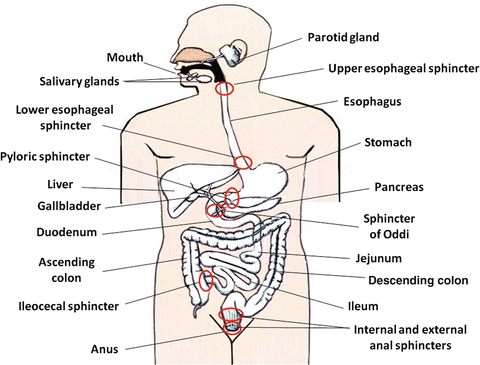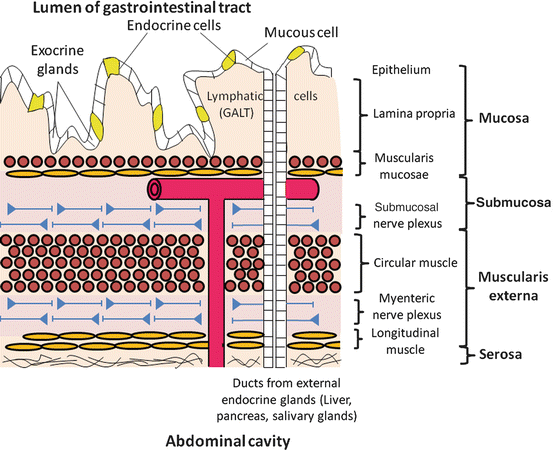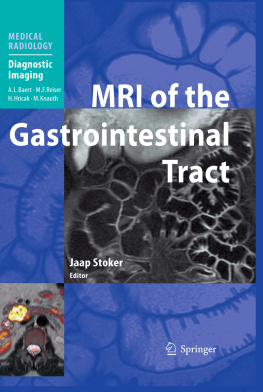1. Regulation of Gastrointestinal Functions
Introduction of the Gastrointestinal System
The Gastro-Intestinal (GI) system is divided into two parts: the luminal GI and hepato-biliary-pancreatic GI .
The luminal (or tubular) GI consists of the alimentary (digestive) canal or GI tract, which extends from the mouth to the anus (Fig. ). The GI tract includes the pharynx , esophagus , stomach , small intestine ( duodenum, jejunum and ileum ) and large intestine ( colon, cecum and rectum ), as well as the anus . The GI tract is a muscular tube of about 5 m long when one is alive; however, after a person dies and during autopsy or postmortem examination, the length of the tract can be doubled to 10 m . This is due to the loss of muscle tone. The GI tract can contract and relax with different transit time in each segment of the tract, which, in turn, depends on its own specific function (i.e. motility or secretion ) of each segment. The motor and secretory activities of the GI system are highly controlled and integrated by the gut endocrine and enteric nervous systems (see Section on Neural and Hormonal Regulators of Gastrointestinal Function).
Fig. 1.1
A schematic diagram of the gastrointestinal system showing the digestive tract and the associated organs. The circled structures indicate the key locations that separate the digestive tract from each other by the structures called sphincters
The hepato-biliary-pancreatic GI consists of the associated glands and organs of the GI system; they include the salivary glands (parotid , sublingual and submandibular glands ), pancreas , gallbladder and liver which empty their secretions into the lumen of the GI (e.g. luminal digestive enzymes). The salivary glands secrete saliva for digestion and lubrication; the pancreas produces hydrolytic enzymes for the digestion of our daily foodstuff and bicarbonate for the neutralization of our gastric contents; the liver secretes bile, which is stored temporarily in the gallbladder and subsequently delivered to the duodenum for fat digestion and absorption.
There are key locations that separate the different parts of the GI tract from each other by a structure called sphincter , e.g. esophageal (upper and lower), pyloric, sphincter of Oddi, ileocecal, and anal sphincters (Fig. ). Sphincters are made up of smooth muscle and they act as the valve of a reservoir for holding luminal content adequately before emptying the content into next segment by their highly coordinated activity. Dysregulation of the activity of sphincters results in GI motility disorders (e.g. Gastroparesis / Dumping Syndrome and Achalasia / Gastro-Esophageal Reflux Disease (GERD) ). As a basic concept, dysfunction of either GI motility or secretion, or both, can lead to some common GI disorders including, but not limiting to, GERD , Peptic ulcer Disease (PUD) , and Diarrhea .
1.1 General Structure of the Gastrointestinal Tract
The structure of the GI tract varies greatly from region to region, but common features exist in the overall organization of the wall of the tract (Fig. ) . From inside out , there are four characteristic layers.
Fig. 1.2
A longitudinal section of the digestive tract wall illustrating the four major gut layers from inside outward, i.e. mucosa , submucosa , muscularis externa and serosa . GALT indicates gut-associated lymphoid tissue (Modified from Widmaier et al. [])
The first layer mucosa is the innermost layer, and it consists of an epithelium, the lamina propria , and the muscularis mucosae . In the epithelium , it contains exocrine gland cells and endocrine cells, which secrete mucus and digestive enzymes into the lumen, and release GI hormones into the blood, respectively. The endocrine cells are interspersed among the epithelial lining and they constitute the gut endocrine system . In the lamina propria , it contains small blood vessels, nerve fibers, and lymphatic cells/tissues, the latter being called gut-associated lymphoid tissue , as introduced in Sect.. In addition, a thin muscle layer called muscularis mucosae is also found and the activity of its muscle is responsible for controlling mucosal blood flow and GI secretion.
The second layer submucosa is a connective tissue with major blood and lymphatic vessels, along with a network of nerve cells, called the submucosal nerve plexus , passing through.
The third layer muscularis externa is a thick muscle and its contraction contributes to major gut motility (segmentation and peristalsis ). This muscle layer typically consists of two substantial layers of smooth muscle cells: an inner circular layer and an outer longitudinal layer . A prominent network of nerve cells, called the myenteric nerve plexus , is also located between the circular and longitudinal smooth muscle layers. The myenteric nerve plexus and the submucosal plexus constitute the enteric nervous system (ENS ) .
The fourth layer serosa is the outermost layer, which mainly consists of connective tissues and it connects to the abdominal wall, thus supporting the GI tract in the abdominal cavity.
1.2 Functions of the Gastrointestinal System
The function of the GI system can be described in terms of four physiological processes: (1) Digestion , (2) Secretion , (3) Absorption and (4) Motility , and the mechanisms by which they are controlled. While digestion, secretion, and absorption are taking place, contractions of smooth muscles in the GI tract wall mix the luminal contents with various secretions and move them through the tract from proximal to distal regions, i.e. from the mouth to the anus . These contractions are referred to as the motility of the GI tract . Physiologically, the motility and secretion are finely tuned in order to achieve optimal digestion and absorption; it in turn facilitates assimilation of nutrients, which is the primary role of our GI system. Put it simply, the overall function of the GI system is to take in nutrients and to eliminate waste. In fact, one can survive without the GI system (yet the liver is still essential for survival) if one is fed parenterally and some vital secretions (such as digestive enzymes, intrinsic factor and insulin ) are replaced.
In general, the cells lining the luminal intestinal organs are exposed to hostile environments, including antigens from food and bacteria, digestive enzymes and various solutions at variable pH levels. In view of this fact, certain non-immunologic defense mechanisms are present to protect against these potential hazards; they include gastric acid secretion, intestinal mucin, epithelial cell permeability barrier and gut peristalsis , which are critical for maintaining the ecology of intestinal flora. For example, abnormally high levels of bacteria in an individual with impaired small intestinal peristalsis can lead to diarrhea and/or steatorrhea (fecal fat excretion), a clinical condition being referred to as Intestinal Blind Loop Syndrome . Of note, the GI tract is also an important part of the immune system of the body. The so-called Gut-Associated Lymphoid Tissue or GALT (Fig. ) consists of both organized aggregates of lymphoid tissue (e.g. Peyers patches ) and diffuse (or migrating) populations of immune cells (e.g. intraepithelial lymphocytes ). GALT has two primary functions: (1 ) protection against the potential microbial pathogens, and (2) permission of immunologic tolerance to both the potentially immunologic dietary substances and bacteria that normally reside primarily in the lumen of the GI tract (called the intestinal microflora ). The GALT and intestinal microflora play critical roles in regulating GI functions, thus having clinical relevance to gut diseases.







